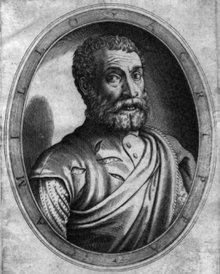- Camillo Agrippa
-
Camillo Agrippa est un architecte, mathématicien et ingénieur italien du XVIe siècle.
Sommaire
Biographie
Camillo Agrippa est très connu pour son Essai sur la Science des Armes (Trattato di Scienza d’Arme, 1553). Les effets de ce petit livre d'Agrippa sont grands, car les principes qui y sont exprimés sont les fondements de l’escrime telle qu'elle est pratiquée aujourd’hui.
C’est Agrippa qui, influencé par la géométrie d’Euclide, et, à la place de la multiplicité des pittoresques gardes médiévales, a introduit quatre gardes où l’épée est tenue devant le corps. Agrippa a exprimé aussi une théorie du mouvement du combat où une action est un temps, selon la Physique d’Aristote qui affirme “le temps est le numéro du mouvement, ” et une conception circulaire du corps humain, selon le Au sujet de l'Architecture de Vitruve. En d’autres mots, il a transformé l’épée de taille medievale en rapière d’estoc Renaissance.
Agrippa est né à Milan, mais il est arrivé à Rome en 1535, où (selon son propre compte), il a discuté avec Michel-Ange et Antonio da Sangallo le Jeune du demenagement de l’obélisque du Cirque Gai et Neronis à la Place Saint-Pierre. (Comme ces deux, qui s’étaient occupé du palais du Cardinal Alexandre Farnese, qui est devenu après le Pape Paul III, Agrippa s’était associé avec le parti Farnese.) Dans sa longue carrière, Agrippa a écrit beaucoup d’œuvres sur des sujets divers, comme la cosmologie, l’origine des temps, la science militaire, et la géologie. Il est mort à Rome vers 1595.
Œuvres
- Dialogo sopra la generazione di venti
- Nuove invenzioni sopra il modo di navigare
- Trattato di transportare la guglia in su la piazza di s. Pietro
- Treatise on the Science of Arms with Philosophical Dialogue
- Dialogo di Camillo Agrippa milanese del modo di mettere in battaglia presto & con facilità il popolo di qual si voglia luogo con ordinanze & batagglie diverse, 1585
Bibliographie
- (en) Cet article est partiellement ou en totalité issu de l’article de Wikipédia en anglais intitulé « Camillo Agrippa » (voir la liste des auteurs)
- De Boni, Filippo, Biografia degli artisti, Venezia, Gondoliere, 1840
- Mazzuchelli, Giammaria Bresciano, Gli scrittori d'Italia: cio, notizie storiche, e critiche intorno alle vite, e agli scritti dei letterati italiani, Brescia, Bossini, 1753-1763
Notes et références
Voir aussi
Liens et documents externes
- (en) Œuvres de Camillo Agrippa sur le projet Gutenberg
- (en) Trattato Di Scientia d’ Arme,con un Dialogo di Filosofia - Treatise on the Science of Arms with Philosophical Dialogue. Version en ligne, au format PDF
- (en) Dialogo del modo di mettere in battaglia - Dialogo di Camillo Agrippa milanese del modo di mettere in battaglia presto & con facilità il popolo di qual si voglia luogo con ordinanze & batagglie diverse. Online Version
- Portail de l’architecture et de l’urbanisme
- Portail des mathématiques
- Portail de l’escrime
- Portail de la Renaissance
- Portail de l’Italie
Catégories :- Naissance à Milan
- Personnalité de la Renaissance
- Architecte italien du XVIe siècle
- Ingénieur italien
- Mathématicien italien
- Histoire de l'escrime
- Date de naissance inconnue (XVe siècle)
- Date de naissance inconnue (XVIe siècle)
- Date de décès inconnue (XVIe siècle)
Wikimedia Foundation. 2010.

